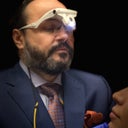Posted underRadiesse q&a
How do collagen fillers show up on scans? Had an MRI recently after having Radiesse in my temples and jawline 20 months ago.
The report stated 'The filler material has turned to collagen and is seen deep to the skin in the tissue between the skin and the bone in the jawline and temples. MRI appearance is typical of collagen fillers (water like appearance)' - I am wondering is this collagen showing up or the product itself? Can collagen from Radiesse and Sculptra show up on scans?
Answers (6)
From board-certified doctors and trusted medical professionals
Dr. Darab Hormozi, MD
Oculoplastic Surgeon, Board Certified in Ophthalmology
Answer
Dr. Francis R. Palmer, III, MD (retired)
Board Certified Facial Plastic Surgeon
Answer
More Radiesse Questions
See all Radiesse Q&AWE SEND PRETTY
EMAILS
What’s trending? Who’s turning heads? Which TikTok myths need busting? We’ve got you. No fluff, no gatekeeping—just real talk. Get our free, unfiltered newsletter.

